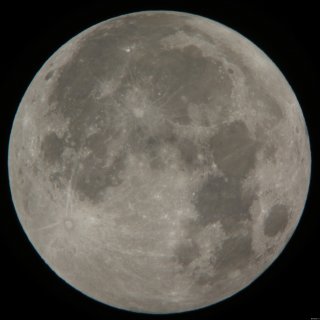Last night’s moon (actually this morning’s, since the best break in the clouds came at 2:30 a.m.) reached full at 1:18 a.m. EST. I wasn’t awake to take its picture, but I woke up soon after full and discovered that, contrary to all expectation, there was a break in the clouds wide enough to permit some lunar photography. So voilà! The first full moon of a lunation that began in 2010:
Lest anyone doubt that the full moon is much brighter than nearly full moons, this images was made at 1/125 second exposure time, f/3.5. The previous night’s image was 1/60; tonight’s image (see next post, please) was also made at 1/60 sec, f/3.5.
And this full moon is brighter than most, because full moon happens to coincide with perigee (moon’s closest approach to Earth) this time around. That doesn’t happen every time. According to Spaceweather.com, this moon was 14% bigger and 30% brighter than the remaining full moons of 2010 are going to be. This is not a particularly infrequent circumstance; a striking example of the difference in full moon size at apogee (farthest from Earth) and perigee was featured in NASA’s Astronomy Picture of the Day back in 2007.
I apologize for the fact that I was unable to orient the image with the polar axis running vertically through the frame; I am still without access to my photo editing software. Apple’s “Preview” only allows me to rotate in increments of 90°. Hopefully I’ll have the situation resolved soon; at least my MBP is back up and running after its run-in with the tile floor!


